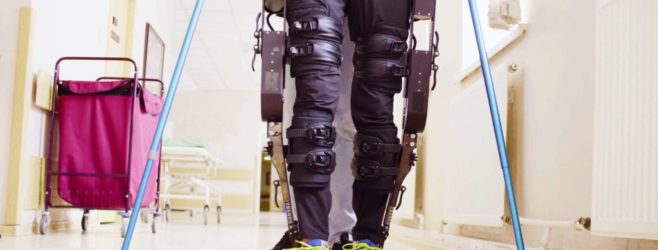Children with cerebral palsy are getting better at walking with the help of wearable robotic devices.
Cerebral palsy is a mobility disorder caused by brain damage that happened around or at birth. Because the damage could be in various places in the brain, symptoms of cerebral palsy vary from person to person.
However, one mobility issue that affects many children with cerebral palsy is difficulty walking — one-third of children with cerebral palsy cannot walk at all.
There is no cure for cerebral palsy. However, many of the symptoms can be managed with physical therapy. Now, physical therapy for cerebral palsy is taking on a futuristic look with the introduction of exoskeletons or wearable robotic devices.
Robotic Exoskeletons As Physical Therapy for Cerebral Palsy
An exoskeleton is a new type of physical therapy for cerebral palsy. It’s a wearable device that combines robotics and electronics with machinery to help improve movement.
The exoskeleton provides the wearer with the strength needed for them to stand and walk on their own. The suit also strengthens the wearer’s muscles and improves their muscle and brain coordination.
When someone performs an action, their brain fires neurons that tell the muscles what to do. The more times the person performs that action, the faster those neurons fire — a process known as muscle memory or the mind-muscle connection. However, children with cerebral palsy who are unable to walk haven’t formed those pathways.
The robotic suits give kids the chance to practice walking in a safe environment and build muscle memory.
The exoskeletons are easy for children with cerebral palsy to use. They’re lightweight, so the child can put more of their energy into walking and less into moving the machinery. The suits are also tailored to each child and their specific needs, so they can practice the motions and use the muscle groups they need to.
Improving Mobility Without Aid
One concern that parents may have about exoskeletons is if these specialized suits can actually help their child get stronger. According to the research team, they are.
These suits do not do all of the work for the wearer. The robot analyzes how the child walks — for example, what muscles they are using and their pattern of walking — and then uses that information to teach the child how to move more effectively and efficiently.
The robotic device teaches them which muscles to use, and by using them more often, it helps the child to strengthen those muscles. The exoskeletons also help the child build muscle memory by enhancing nerve connections. These two aspects (muscle memory and stronger muscles) are both needed for the child to eventually walk on their own.
The fact that the exoskeleton doesn’t do all of the work for the child touches on an important principle of physical rehabilitation — training the mind-muscle connection.
People With Cerebral Palsy Benefit From Physical Rehabilitation
Living with cerebral palsy is not easy:
- One in three cannot walk
- One out of four has epilepsy
- Three out of four experience chronic pain
Children with cerebral palsy may also have symptoms like weak, stiff, or shaky muscles. It can impact their ability to talk, breathe, eat, and control their neck muscles.
Thankfully, research shows that their mobility and vocal issues can be rehabilitated over time with different therapies, such as those that now include new technology like robotics.
If you are a parent of a child with cerebral palsy, you may have options for legal compensation, which can help you afford physical therapies and emerging robotic-based treatments. To find out more, contact the Birth injury Justice Center today.



